How does the bitcoin source code define its 21 million cap?
Many of bitcoin’s staunchest critics have expressed doubt about its 21 million cap, but perhaps the most mindless criticism relates…
,
Have you ever heard a smart sounding friend say that they aren’t sure about bitcoin but they believe in blockchain technology? This is like saying you believe in airplanes but you’re not sure about the wings; and there’s a good chance that anyone who thinks that may not understand either. In reality, bitcoin and its blockchain are dependent on each other. However, if new to bitcoin, understanding how it works and parsing the landscape can be incredibly difficult. Frankly, it can be overwhelming; given the complexity and sheer volume of projects, who has the time to possibly evaluate everything? There is in fact a manageable path but you have to know where to start. While there are seemingly thousands of cryptocurrencies and blockchain initiatives, there is really only one that matters: bitcoin. Ignore everything else like it didn’t exist and first try to develop an understanding of why bitcoin exists and how it works; that is the best foundation to then be able to think about the entirety of everything else.
It is also the most practical entry point; before taking a flyer and risking hard-earned value, take the time to understand bitcoin and then use that knowledge to evaluate the field. There is no promise that you will come to the same conclusions, but more often than not, those who take the time to intuitively understand how and why bitcoin works more easily recognize the flaws inherent in the field. And even if not, starting with bitcoin remains your best hope of making an informed and independent assessment. Ultimately, bitcoin is not about making money and it’s not a get-rich-quick scheme; it is fundamentally about storing the value you have already created, and no one should risk that without a requisite knowledge base. Within the world of digital currencies, bitcoin has the longest track record to assess and the greatest amount of resources to educate, which is why bitcoin is the best tool to learn.
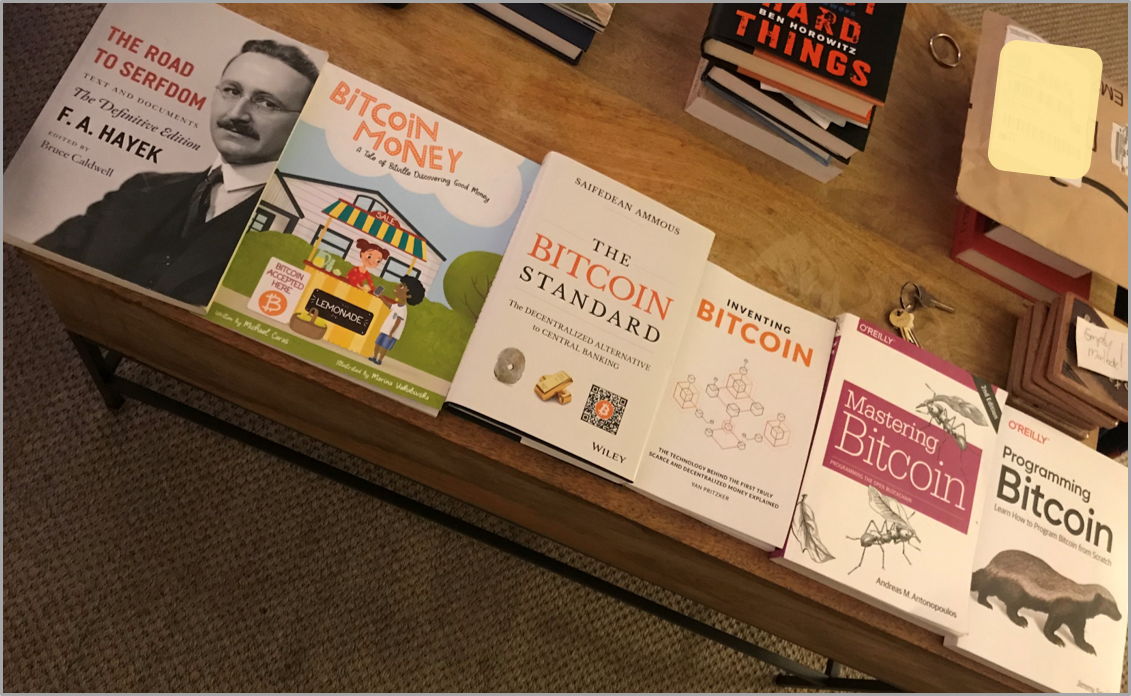
To start on this journey, first realize that bitcoin was created to specifically address a problem that exists with modern money. The founder of bitcoin set out to create a peer-to-peer digital cash system without the need for a trusted third-party, and a blockchain was one critical part of the solution. In practice, bitcoin (the currency) and its blockchain are interdependent. One does not exist without the other; bitcoin needs its blockchain to function and there would not be a functioning blockchain without a native currency (bitcoin) to properly incentivize resources to protect it. That native currency must be viable as a form of money because it is exclusively what pays for security, and it must have credible monetary properties in order to be viable.
Without the money, there is no security and without the security, the value of the currency and the integrity of the chain both break down. It is for this reason that a blockchain is only useful within the application of money, and money does not magically grow on trees. Yep, it is that simple. A blockchain is only good for one thing, removing the need for a trusted third-party which only works in the context of money. A blockchain cannot enforce anything that exists outside the network. While a blockchain would seem to be able to track ownership outside the network, it can only enforce ownership of the currency that is native to its network. Bitcoin tracks ownership and enforces ownership. If a blockchain cannot do both, any records it keeps will be inherently insecure and ultimately subject to change. In this sense, immutability is not an inherent trait of a blockchain but instead, an emergent property. And if a blockchain is not immutable, its currency will never be viable as a form of money because transfer and final settlement will never be reliably possible. Without reliable final settlement, a monetary system is not functional and will not attract liquidity.
Ultimately, monetary systems converge on one medium because their utility is liquidity rather than consumption or production. And liquidity consolidates around the most secure, long-term store of value; it would be irrational to store wealth in a less secure, less liquid monetary network if a more secure, more liquid network existed as an attainable option. The aggregate implication is that only one blockchain is viable and ultimately necessary. Every other cryptocurrency is competing for the identical use case as bitcoin, that of money; some realize it while others do not but value continues to consolidate around bitcoin because it is the most secure blockchain by orders of magnitude and all are competing for the same use case. Understanding these concepts is fundamental to bitcoin and it also provides a basic foundation to then consider and evaluate the noise beyond bitcoin. With basic knowledge of how bitcoin actually works, it becomes clear why there is no blockchain without bitcoin.
Often, bitcoin’s transaction ledger is thought of as a public blockchain that lives somewhere in the cloud like a digital public square where all transactions are aggregated. However, there is no central source of truth; there are no oracles and there is no central public blockchain to which everyone independently commits transactions. Instead, every participant within the network constructs and maintains its own independent version of the blockchain based on a common set of rules; no one trusts anyone and everyone validates everything. Everyone is able to come to the same version of the truth without having to trust any other party. This is core to how bitcoin solves the problem of removing third-party intermediaries from a digital cash system.
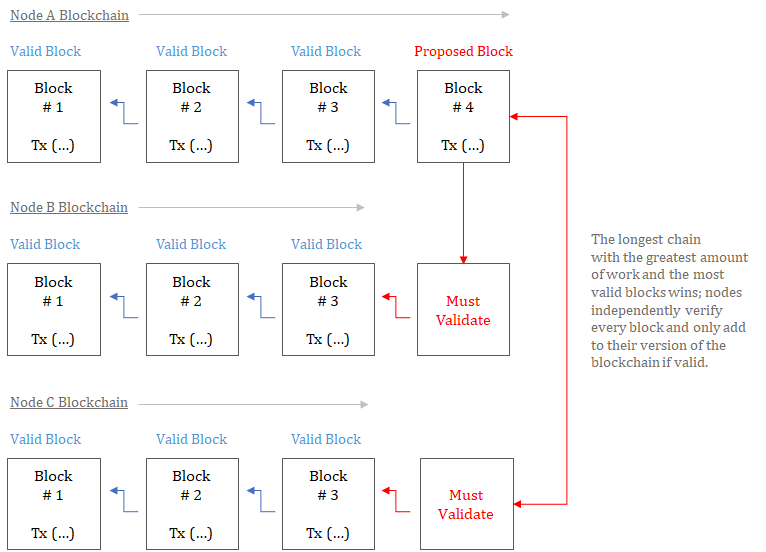
Every participant running a node within the bitcoin network independently verifies every transaction and every block; by doing so, each node aggregates its own independent version of the blockchain. Consensus is reached across the network because each node validates every transaction (and each block) based on a core set of rules (and the longest chain wins). If a node broadcasts a transaction or block that does not follow consensus rules, other nodes will reject it as invalid. It is through this function that bitcoin is able to dispose with the need for a central third-party; the network converges on the same consistent state of the chain without anyone trusting any other party. However, the currency plays an integral role in coordinating bitcoin’s consensus mechanism and ordering blocks which ultimately represents bitcoin’s full and valid transaction history (or its blockchain).
Think of a block as a dataset that links the past to the present. Technically, individual blocks record changes to the overall state of bitcoin ownership within a given time interval. In aggregate, blocks record the entire history of bitcoin transactions as well as ownership of all bitcoin at any point in time. Only changes to the state are recorded in each passing block. How blocks are constructed, solved and validated is critical to the process of network consensus, and it also ensures that bitcoin maintains a fixed supply (21 million). Miners compete to construct and solve blocks that are then proposed to the rest of the network for acceptance. To simplify, think of the mining function as a continual process of validating history and clearing pending bitcoin transactions; with each block, miners add new transaction history to the blockchain and validate the entire history of the chain. It is through this process that miners secure the network; however, all network nodes then check the work performed by miners for validity, ensuring network consensus is enforced. More technically, miners construct blocks that represent data sets which include three critical elements (again simplifying):
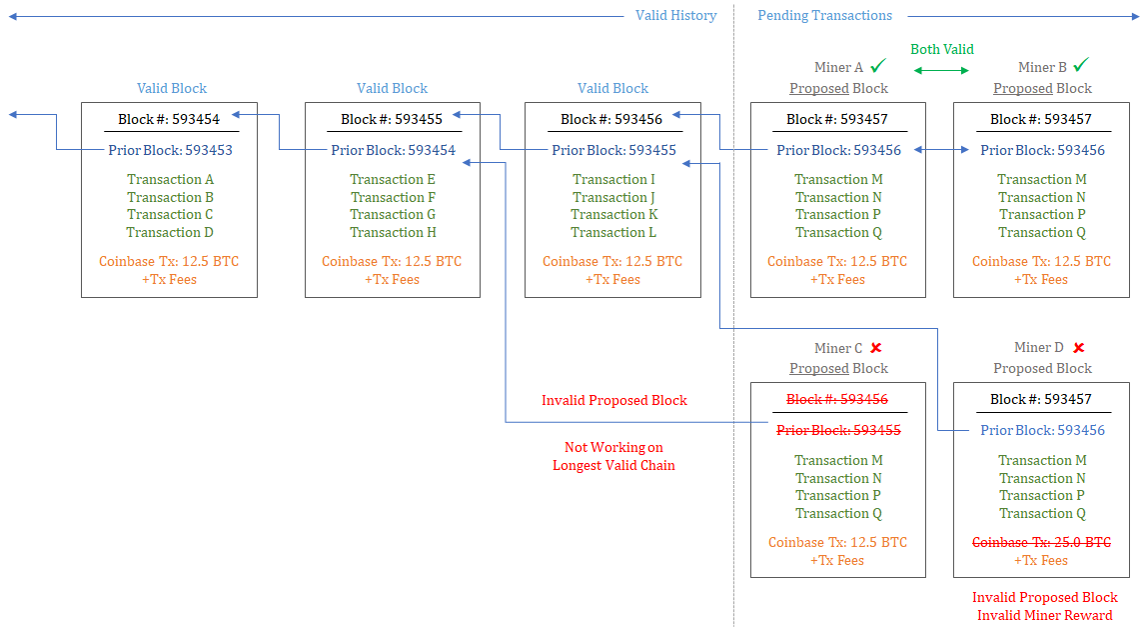
To solve blocks, miners perform what is known as a proof of work function by expending energy resources. In order for blocks to be valid, all inputs must be valid and each block must satisfy the current network difficulty. To satisfy the network difficulty, a random value (referred to as a nonce) is added to each block and then the combined data set is run through bitcoin’s cryptographic hashing algorithm (SHA-256); the resulting output (or hash) must achieve the network’s difficulty in order to be valid. Think of this as a simple guess and check function, but probabilistically, trillions of random values must be guessed and checked in order to create a valid proof for each proposed block. The addition of a random nonce may seem extraneous. But, it is this function that forces miners to expend significant energy resources in order to solve a block, which ultimately makes the network more secure by making it extremely costly to attack.
Adding a random nonce to a proposed block, which is an otherwise static data set, causes each resulting output (or hash) to be unique; with each different nonce checked, the resulting output has an equally small chance of achieving the network difficulty (i.e. representing a valid proof). While it is often referred to as a highly complicated mathematical problem, in reality, it is difficult only because a valid proof requires guessing and checking trillions of possible solutions. There are no shortcuts; energy must be expended. A valid proof is easy to verify by other nodes but impossible to solve without expending massive amount of resources; as more mining resources are added to the network, the network difficulty increases, requiring more inputs to be checked and more energy resources to be expended to solve each block. Essentially, there is material cost to miners in solving blocks but all other nodes can then validate the work very easily at practically no cost.
In aggregate, the incentive structure allows the network to reach consensus. Miners must incur significant upfront cost to secure the network but are only paid if valid work is produced; and the rest of the network can immediately determine whether work is valid or not based on consensus rules without incurring cost. While there are a number of consensus rules, if any pending transaction in a block is invalid, the entire block is invalid. For a transaction to be valid, it must have originated from a previous, valid bitcoin block and it cannot be a duplicate of a previously spent transaction; separately, each block must build off the most up to date version of history in order to be valid and it must also include a valid coinbase transaction. A coinbase transaction rewards miners with newly issued bitcoin in return for securing the network but it is only valid if the work is valid.
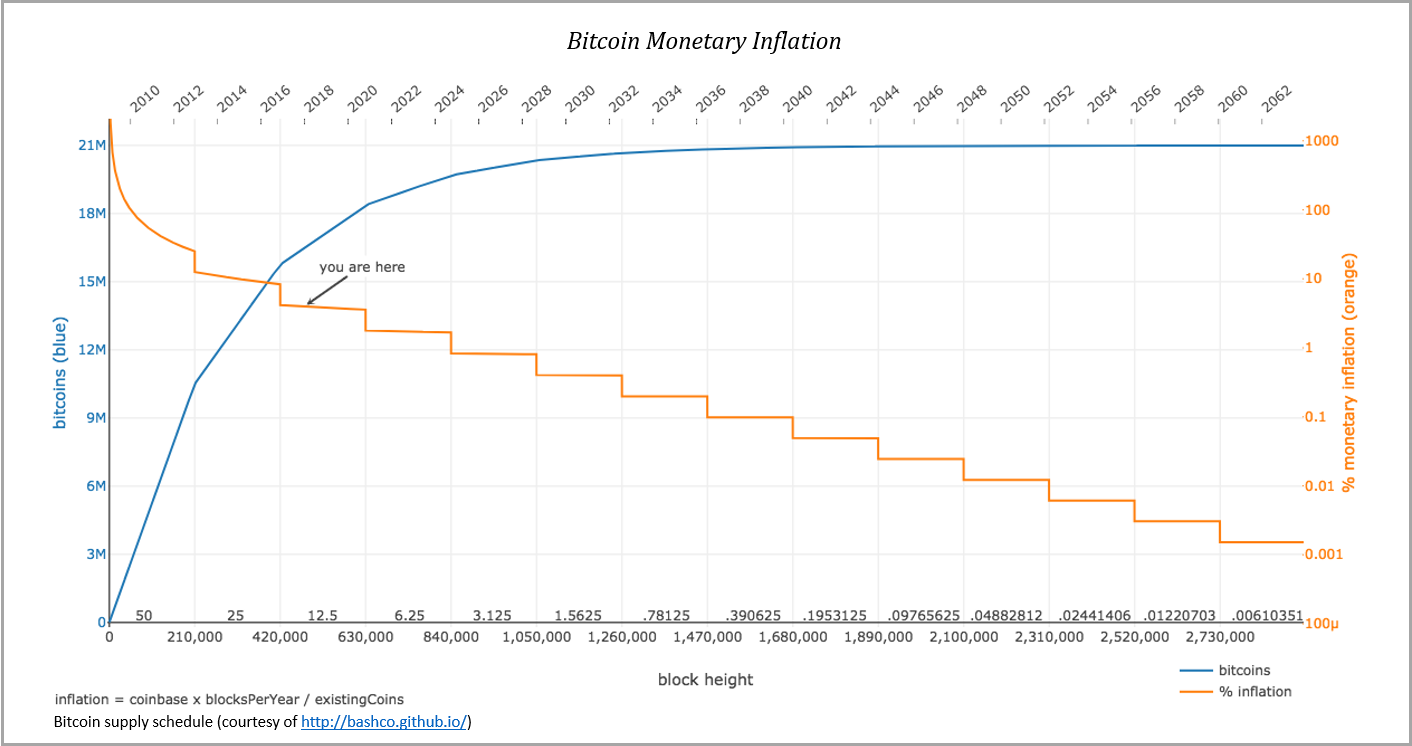
Coinbase rewards are governed by a predetermined supply schedule and currently, 12.5 new bitcoin are issued in each valid block; in approximately eight months, the reward will be cut in half to 6.25 new bitcoin, and every 210,000 blocks (or approximately every four years), the reward will continue to be halved until it ultimately reaches zero. If miners include an invalid reward in a proposed block, the rest of the network will reject it as invalid which is the base mechanism that governs a capped total supply of 21 million bitcoin. However, software alone is insufficient to ensure either a fixed supply or an accurate transaction ledger; economic incentives hold everything together.
Why is this so important? Within one integrated function, miners validate history, clear transactions and get paid for security on a trustless basis; the integrity of bitcoin’s fixed supply is embedded in its security function, and because the rest of the network independently validates the work, consensus can be reached on a decentralized basis. If a miner completes valid work, it can rely on the fact that it will be paid on a trustless basis. Conversely, if a miner completes invalid work, the rest of the network enforces the rules, essentially withholding payment until valid work is completed. And supply of the currency is baked into validity; if a miner wants to be paid, it must also enforce the fixed supply of the currency, further aligning the entire network. The incentive structure of the currency is so strong that everyone is forced to adhere to the rules, which is the chief facilitator of decentralized consensus.
If a miner solves and proposes an invalid block, specifically one that either includes invalid transactions or an invalid coinbase reward, the rest of the network will reject it as invalid. Separately, if a miner builds off a version of history that does not represent the longest chain with the greatest proof of work, any proposed block would also be considered invalid. Essentially, as soon as a miner sees a new valid block proposed in the network, it must immediately begin to work on top of that block or risk falling behind and performing invalid work at a sunk cost. As a consequence, in either scenario, if a miner were to produce invalid work, it would incur real cost but would be compensated nothing in return.

Through this mechanism, miners are maximally incentivized to produce honest, valid work and to work within the consensus of the chain at all times; it is either be paid or receive nothing. It is also why the higher the cost to perform the work, the more secure the network becomes. The more energy required to write or rewrite bitcoin’s transaction history, the lower the probability that any single miner could (or would) undermine the network. The incentive to cooperate increases as it becomes more costly to produce work which would otherwise be considered invalid by the rest of the network. As network security increases, bitcoin becomes more valuable. As the value of bitcoin rises and as the costs to solve blocks increases, the incentive to produce valid work increases (more revenue but more cost) and the penalty for invalid work becomes more punitive (no revenue and more cost).
Why don’t the miners collude? First, they can’t. Second, they tried. But third, the fundamental reason is that as the network grows, the network becomes more fragmented and the economic value compensated to miners in aggregate increases; from a game theory perspective, more competition and greater opportunity cost makes it harder to collude and all network nodes validate the work performed by miners which is a constant check and balance. Miners are merely paid to perform a service and the more miners there are, the greater the incentive to cooperate because the probability that a miner is penalized for invalid work increases as more competition exists. And recall that random nonce value; it seemed extraneous at the time but it is core to the function that requires energy resources be expended. It is this tangible cost (skin in the game) combined with the value of the currency which incentivizes valid work and which allows the network to reach consensus.
Because all network nodes independently validate blocks and because miners are maximally penalized for invalid work, the network is able to form a consensus as to the accurate state of the chain without relying on any single source of knowledge or truth. None of this decentralized coordination would be possible without bitcoin, the currency; all the bitcoin network has to compensate miners in return for security is its native currency, whether that is largely in the form of newly issued bitcoin today or exclusively in the form of transaction fees in the future. If the compensation paid to miners were not reasonably considered to be a reliable form of money, the incentive to make the investments to perform the work would not exist.
Recall from Bitcoin Can’t Be Copied, if an asset’s primary (if not sole) utility is the exchange for other goods and services, and if it does not have a claim on the income stream of a productive asset (such as a stock or bond), it must compete as a form of money and will only store value if it possesses credible monetary properties. Bitcoin is a bearer asset, and it has no utility other than the exchange for other goods or services. It also has no claim on the income stream of a productive asset. As such, bitcoin is only valuable as a form of money and it only holds value because it has credible monetary properties (read The Bitcoin Standard, chapter 1). By definition, this is true of any blockchain; all any blockchain can offer in return for security is a monetary asset native to the network, without any enforceable claims outside the network, which is why a blockchain can only be useful in connection to the application of money. The chart below from The Bitcoin Standard articulates this point:
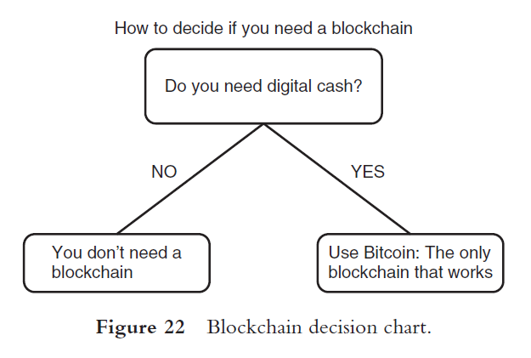
Without a native currency, a blockchain must rely on trust for security which eliminates the need for a blockchain in the first place. In practice, the security function of bitcoin (mining), which protects the validity of the chain on a trustless basis, requires significant upfront capital investment in addition to high marginal cost (energy consumption). In order to recoup that investment and a rate of return in the future, the payment in the form of bitcoin must more than offset the aggregate costs, otherwise the investments would not be made. Essentially, what the miners are paid to protect (bitcoin) must be a reliable form of money in order to incentivize security investments in the first place.
This is also fundamental to the incentive structure that aligns the network; miners have an embedded incentive to not undermine the network because it would directly undermine the value of the currency in which miners are compensated. If bitcoin were not valued as money, there would be no miners, and without miners, there would be no chain worth protecting. The validity of the chain is ultimately what miners are paid to protect; if the network could not reasonably come to a consensus and if ownership were subject to change, no one could reasonably rely on bitcoin as a value transfer mechanism. The value of the currency ultimately protects the chain, and the immutability of the chain is foundational to the currency having value. It’s an inherently self-reinforcing relationship.
Immutability is an emergent property in bitcoin, not a trait of a blockchain. A global, decentralized monetary network with no central authority could not function without an immutable ledger (i.e. if the history of the blockchain were insecure and subject to change). If settlement of the unit of value (bitcoin) could not reliably be considered final, no one would reasonably trade real world value in return. As an example, consider a scenario in which one party purchased a car from another in return for bitcoin. Assume the title for the car transfers, and the individual that purchased the car takes physical possession. If bitcoin’s record of ownership could easily be re-written or altered (i.e. changing the history of the blockchain), the party that originally transferred the bitcoin in return for the car could wind up in possession of both the bitcoin and the car, while the other party could end up with neither. This is why immutability and final settlement is critical to bitcoin’s function.
Remember that bitcoin has no knowledge of the outside world; all bitcoin knows how to do is issue and validate currency (whether a bitcoin is a bitcoin). Bitcoin is not capable of enforcing anything that exists outside the network (nor is any blockchain); it is an entirely self-contained system and the bitcoin network can only ever validate one side of a two-sided value transfer. If bitcoin transfers could not reliably be considered final, it would be functionally impossible to ever trade anything of value in return for bitcoin. This is why the immutability of bitcoin’s blockchain is inextricably linked to the value of bitcoin as a currency. Final settlement in bitcoin is possible but only because its ledger is reliably immutable. And its ledger is only reliably immutable because its currency is valuable. The more valuable bitcoin becomes, the more security it can afford; the greater the security, the more reliable and trusted the ledger.

Ultimately, immutability is an emergent property, but it is dependent on other emergent network properties. As bitcoin becomes more decentralized, it becomes increasingly difficult to alter the network’s consensus rules and increasingly difficult to invalidate or prevent otherwise valid transactions (often referred to as censorship-resistance). As bitcoin proves to be increasingly censorship-resistant, confidence in the network grows, which fuels adoption, which further decentralizes the network, including its mining function. In essence, bitcoin becomes more decentralized and more censorship-resistant as it grows, which reinforces the immutability of its blockchain. It becomes increasingly difficult to change the history of the blockchain because each participant gradually represents a smaller and smaller share of the network; regardless of how concentrated ownership of the network and mining may be at any point in time, both decentralize over time so long as value increases, which causes bitcoin to become more and more immutable.
This multi-dimensional incentive structure is complicated but it is critical to understanding how bitcoin works and why bitcoin and its blockchain are dependent on each other. Why each is a tool that relies on the other. Without one, the other is effectively meaningless. And this symbiotic relationship only works for money. Bitcoin as an economic good is only valuable as a form of money because it has no other utility. This is true of any asset native to a blockchain. The only value bitcoin can ultimately provide is through present or future exchange. And the network is only capable of a single aggregate function: validating whether a bitcoin is a bitcoin and recording ownership.
The bitcoin network is a closed loop and an entirely independent system; its only connection to the physical world is through its security and clearing function. The blockchain maintains a record of ownership and the currency is used to pay for the security of those records. It is through the function of its currency that the network can afford a level of security to ensure immutability of the blockchain, which allows network participants to more easily and consistently reach consensus without the need for trust in any third-parties. The cumulative effect is a decentralized and trustless monetary system with a fixed supply that is global in reach and accessible on a permissionless basis.
Every other fiat currency, commodity money or cryptocurrency is competing for the exact same use case as bitcoin whether it is understood or not, and monetary systems tend to a single medium because their utility is liquidity rather than consumption or production. When evaluating monetary networks, it would be irrational to store value in a smaller, less liquid and less secure network if a larger, more liquid and more secure network existed as an attainable option. Bitcoin is valuable, not because of a particular feature, but instead, because it achieved finite, digital scarcity. This is the backbone of why bitcoin is secure as a monetary network and it is a property that is dependent on many other emergent properties.
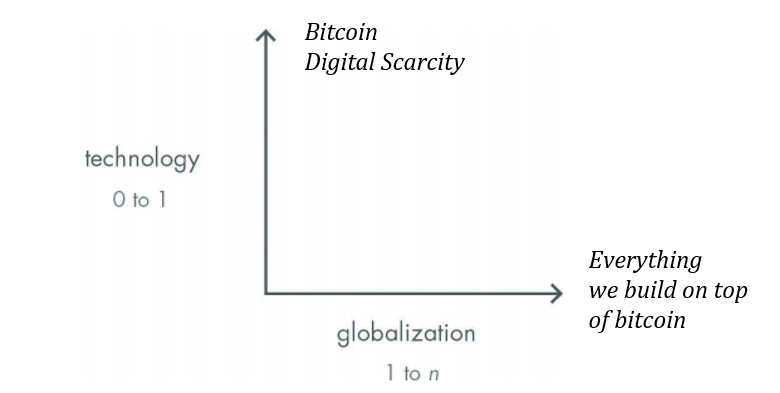
A blockchain on the other hand is simply an invention native to bitcoin that enables the removal of trusted third parties. It serves no other purpose. It is only valuable in bitcoin as a piece to a larger puzzle and it would be useless if not functioning in concert with the currency. The integrity of bitcoin’s scarcity and the immutability of its blockchain are ultimately dependent on the value of the currency itself. Confidence in the aggregate function drives incremental adoption and liquidity which reinforces and strengthens the value of the bitcoin network as a whole. As individuals opt in to bitcoin, they are at the same time, opting out of inferior monetary networks. This is fundamentally why the emergent properties in bitcoin are next to impossible to replicate and why its monetary properties become stronger over time (and with greater scale), while also at the direct expense of inferior monetary networks.
“I don’t believe we shall ever have a good money again before we take the thing out of the hands of government, that is, we can’t take them violently out of the hands of government, all we can do is by some sly roundabout way introduce something that they can’t stop.” -F. A. Hayek
Ultimately, a blockchain is only useful in the application of money because it is dependent on a native currency for security. Bitcoin represents the most secure blockchain by orders of magnitude. Because all other blockchains are competing for the same fundamental use case of money and because bitcoin’s network effects only continue to increase its security and liquidity advantage over the field, no other digital currency can compete with bitcoin. Liquidity begets liquidity and monetary systems tend to one medium as a derivative function. Bitcoin’s security and liquidity obsoleted any other cryptocurrencies before they left the proverbial gates. Find me a cryptocurrency that comes close to bitcoin relative to security, liquidity or the credibility of its monetary properties, and I will find you a unicorn.
The real competition for bitcoin has and will remain the legacy monetary networks, principally the dollar, euro, yen and gold. Think about bitcoin relative to these legacy monetary assets as part of your education. Bitcoin does not exist in a vacuum; it represents a choice relative to other forms of money. Evaluate it based on the relative strengths of its monetary properties and once a baseline is established between bitcoin and the legacy systems, this will then provide a strong foundation to more easily evaluate any other blockchain related project.
To learn more, I suggest reading, The Bitcoin Standard (Saifedean Ammous), Inventing Bitcoin (Yan Pritzker) and Mastering Bitcoin (Andreas Antonopolous), probably in that order.
Next week: Bitcoin is Not Backed by Nothing
Thanks to Will Cole, Phil Geiger and Adam Tzagournis for reviewing and providing valuable feedback. Also thanks to Saif, Yan and Andreas for their books which are incredible resources.
Views presented are expressly my own and not those of Unchained Capital or my colleagues.
Many of bitcoin’s staunchest critics have expressed doubt about its 21 million cap, but perhaps the most mindless criticism relates…
Ted Stevenot, Stephen HallWhen Satoshi Nakamoto created bitcoin, he established in its code a fixed number of bitcoin that will ever exist. Since…
Ted StevenotOriginally published in Parker’s dedicated Gradually, Then Suddenly publication. Bitcoin is often described as a hedge, or more specifically, a…
Parker Lewis